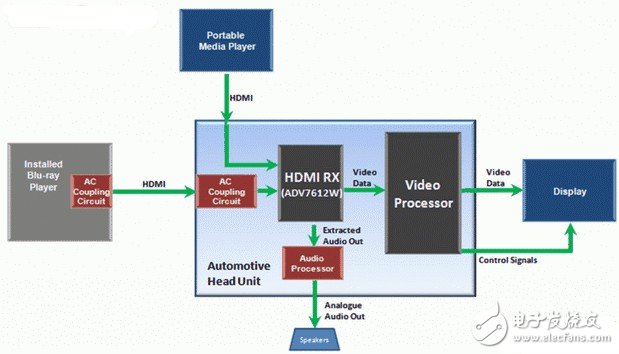Introduction
Playing high-definition content (such as movies on Blu-ray Discs) requires a lot of processing power, which is not currently available in existing processors in current car infotainment systems. With the HDMI industry standard, automakers can integrate automotive HD movie playback capabilities more quickly and easily. Such systems can use automotive-grade Blu-ray drives that connect using E-type cables and connectors listed in the HDMI specification. Because the HDMI standard provides content protection for simultaneous audio (including multi-channel HD audio formats) and video transmission, there is no need to connect to the audio amplifier separately through other network or audio buses.
The Blu-ray player's playback function is just one application of HDMI in the automotive industry. More and more passengers and drivers are hoping to connect their mobile devices to car infotainment systems. In the near future, smartphones are expected to become entertainment centers, significantly reducing the processing requirements, complexity and cost of automotive infotainment systems. The design cycle of smartphones is much shorter than that of automotive infotainment systems. If smartphones become the hub of equipment, they can ensure that the latest consumer product developments can be quickly applied to automotive infotainment systems. HDMI delivers high quality, uncompressed feeds, making it ideal for connecting mobile devices to automotive infotainment systems. For the automotive industry, HDMI cables have low noise coupling and are not susceptible to other devices in the car.

Figure 1 shows an example of an HDMI application in a car design.
The audio host (the main controller of the car infotainment system) has two HDMI inputs, one audio output, and one display video output. The HDMI receiver (Rx) decodes the video from the two HDMI inputs and extracts the audio. The audio is converted to an analog signal and connected to the speaker. The first HDMI input is connected to the installed Blu-ray player, which may be located in the trunk of the car. The second HDMI input provides connectivity to portable media devices equipped with HDMI, including smartphones, tablets, laptops, digital cameras and camcorders.
The HDMI interface is commonly used in consumer electronics, but how do you integrate it into automotive applications?
Although the HDMI interface is currently widely used in various home entertainment devices, automotive applications pose new challenges to the design using the HDMI interface. Automotive applications may include open systems or closed systems. Open systems allow for the connection of consumer devices such as smartphones or tablets. A closed system allows dedicated modules within the car entertainment system to be interconnected.
Heat film on Agriculture applications including : greenhouse seedling breeding Heating film, agricultural vegetable greenhouses heating film,,Seedling Heat Mat,Flowerpot heat mat etc.The application of heating film in animal husbandry, such as: hatching fowl heating film,far infrared sterilization heating film,etc.we are a professional and leader Chinese exporter of heat film,Customization options (for example: SMT components, flex cable and connectors) can provide the perfect complete solution that can significantly reduce assembly time and increase productivity.Providing a variety of complex shapes design, and different power designs. Membrane in the same piece electrically heated heating circuit can be designed and holding circuit,we are looking forward to your cooperation.
Seedling Heater Tray,Electric Growing Tray for Plant,Heater Mat,Seeding Heater Mat
ShenZhen XingHongChang Electric CO., LTD. , https://www.xhc-heater.com